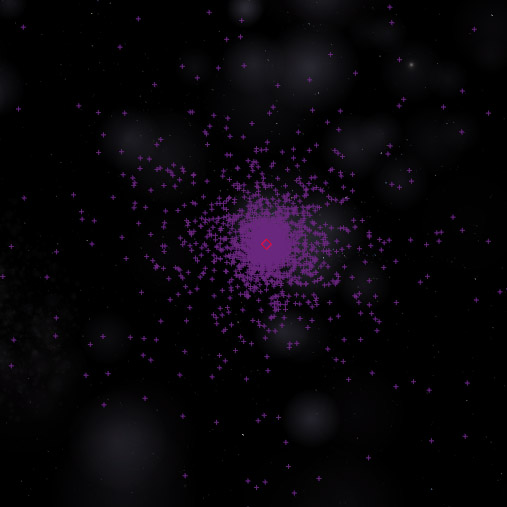Page 1 of 1
Spectral class ? in Celestia
Posted: 29.07.2007, 23:00
by Cham
Using a variation of some script from Vincent, I discovered that there are lots of stars with the undefined spectral class "?" in Celestia, all in the vicinity of Sol (the red marker in the picture below) :

For example, KSI Sco B (part of a binary system) and HIP 13977 (single star) are of undefined spectral class.
What is this strangeness ?
Here's the CELX script I used to mark those stars :
Code: Select all
function mark_spectraltype(x)
local obs = celestia:getobserver()
local nstars = celestia:getstarcount()
local i = 0
-- while i < nstars do
-- star = celestia:getstar(i)
for star in celestia:stars() do
first, last = string.find(star:spectraltype(), x, 1, true)
if first == 1 then
star:mark("#6A287E", "plus", 5)
end
i = i + 1
end
end
spectral = "?"
mark_spectraltype(spectral)
Posted: 29.07.2007, 23:12
by ajtribick
Many of the binaries in the visualbins and spectbins have ? for secondaries (and apparent magnitude 5.00).
What does that plot look like if you disable these two files?
Posted: 29.07.2007, 23:17
by Cham
I don't think it should change very much, since there isn't a large amount of binaries in Celestia.
Posted: 30.07.2007, 07:49
by t00fri
chaos syndrome wrote:Many of the binaries in the visualbins and spectbins have ? for secondaries (and apparent magnitude 5.00).
What does that plot look like if you disable these two files?
Since my data files are based on REALLY existing measurements, ? means what it is meant to mean

.
But statistically, the weight of binaries from visualbins and spectbins with (partly) unknown spectral class is low
Bye Fridger
Re: Spectral class ? in Celestia
Posted: 30.07.2007, 07:55
by t00fri
Cham wrote:For example, KSI Sco B (part of a binary system) and HIP 13977 (single star) are of undefined spectral class.
What is this strangeness ?
It means that either the respective spectral classes seem to be lacking in the HIP data or that there are formats that are not correctly parsed by the Celestia code. The latter may easily be checked. In the former case, more catalogs would have to be logically combined (via PERL), to assign more unknown spectral classes. This is a similiarly tedious affair than in case of my galaxy data (deepsky.dsc), where now as many as 10 different catalogs are merged to extract a maximum of distance values...
Bye Fridger
Posted: 30.07.2007, 08:01
by Cham
I feel there's a problem, with the spectral classes in Celestia. It's a shame that so much "nearby" stars don't have a proper spectral class, in an astronomy software which is supposed to be on a scientific level. Also, apparently, Celestia's code is just "reading" the first letter to many spectral classes. The CELX scripts I'm trying to do are unable to read the second number. And Celestia's evaluation of cool red stars radius really sucks. It needs to be corrected. The red dwarfs are way too small. These limitations are killing the usefullness of Celestia, as a scientific astronomy software.
Posted: 30.07.2007, 15:38
by Hungry4info
Cham wrote:...These limitations are killing the usefullness of Celestia, as a scientific astronomy software.
I absolutely agree.
Posted: 31.07.2007, 18:21
by t00fri
So we have to do something about this....
Looking through data/stars.txt of the Celestia source distribution, the vast majority of the HIP stars seems to be associated with a spectral class (last column). So indeed, perhaps the parsing needs improvement.
Bye Fridger
Posted: 31.07.2007, 18:28
by Cham
About stars, I have the strong impression that Celestia is unreliable and can't be trusted. It needs a major face lifting (update to all stars in the database, including the binaries). Unfortunately, I can't help much here.

